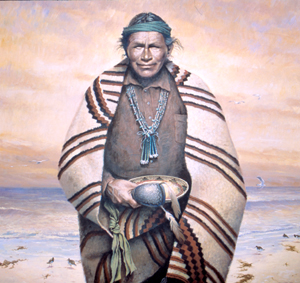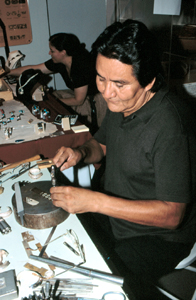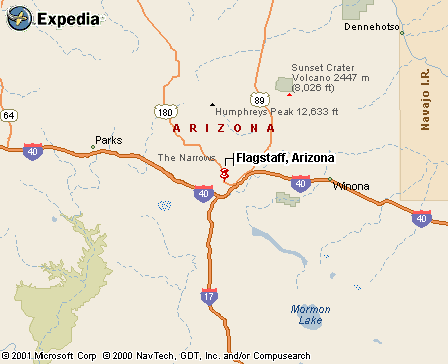|
|
Canku Ota |
|
|
(Many Paths) |
||
|
An Online Newsletter Celebrating Native America |
||
|
August 23, 2003 - Issue 94 |
||
|
|
||
|
MNA celebrates 54th Navajo Marketplace |
||
|
by S.J. Wilson - Navajo-Hopi
Observer
|
||
|
FLAGSTAFF - Going to the annual Navajo Marketplace at the Museum of Northern Arizona is like a family reunion for many, though far, far more colorful. Each year, Flagstaff's MNA hallways, courtyards and galleries are filled to bursting with Navajo artists of numerous mediums, demonstrating and selling their art. This year the Navajo Showplace took place the weekend of Aug. 2-3. Redwing Nez was only one of several artists who expressed their affection for the marketplace. Nez has exhibited at the museum often, and took the Best of Show award in 1984. This year he has come as a guest. "It's good to see people," Nez said. "The museum is like a grandmother. Sometimes you leave home, you go through a lot in your life, and you come home to visit her." Nez said that he was introduced MNA during the second annual Navajo exhibition, back in 1979 or '80. "The museum has nourished me," Nez added. "It's nice to come back to visit. My feelings are still here, and, as always, I am impressed with the integrity and showmanship displayed during this event." Longtime
exhibitor
"Art means everything to me," he said. "It's how I make my living; it's how I express my creative side." Bahe has been painting off and on for 15 of the last 25 years, and said he feels he's finally arrived where he needs to be in terms of his career. Bahe's extraordinary attention to detail includes a great deal of research - demonstrated in his interpretive painting of Navajo medicine man, Hosteen Klah. Staring into the face of Klah as depicted by Bahe, one can't help but feel this historical figure's good nature. Inscribed
on the back of this intriguing painting, purchased by a local private
collector, is the history of how it was that Klah happened to be
standing on a wave-swept beach almost a century ago: Although much of the face of Klah was taken from photographs, his clothing, his position on the beach, indeed even the water birds, are inspired by knowledge, research and Bahe's imagination. Bahe took second place for another of his vibrant acrylics entitled "Earned Status." Intensity
of hue "I'm not consistent with one theme," Franklin said "I love bright colors, used full strength." Standing comfortably in front of his work, "Visitation at the Ocean Side," - depicting a slender young Navajo woman at the beach, a parasol held protectively over her head - Franklin described the visit to the beach in San Diego where he sat studying the motion of the sea. He often draws on his travels and adventures as themes for his work. He spent six years - from 1966 to 1972 - traveling throughout the country. One memorable event was his participation in the occupation of Alcatraz Island by American Indians in 1969. During this time he said he had no inkling of the talent he possessed. Upon his return from California, Franklin enrolled in some courses at Northern Arizona University, which he kept up "through trial and error." Another piece, "Ominous Moment" depicts an almost paranoid looking blue face, and represents yet what Franklin described as another "tangent of expression." "It is different. I wanted to give it a try," he said. "I'm not afraid to express my soul and push myself beyond my present mind. It's life experiences that give me my ideas; they are my influence." Franklin used to come to MNA's Navajo Showplace every year - until attention there turned from Native American art towards dinosaur exhibits, he said. "You might say we were displaced by dinosaurs," Franklin chuckled. But with the museum's return to the tribal showplaces, Franklin too has come home, so to speak.
Another feature of Clark's work is that the people in his paintings invite the viewer's attention by meeting their eyes - looking straight out of the canvas. Clark has spent the better part of a year with his mother, Modesta Clark, 89 years of age, who he describes as very traditional. "She is in good health, but she lives 15 miles off the road," he said. "We agreed that I would come and spend one year with her." That year ends in October, when a brother will take his place. "I gave up my possessions of luxury to spend this time with her," Clark admitted. These include his computer, his microwave and other electronic devices, to live a physically demanding life that includes chopping wood and hauling water. All he took with him were his clothes and painting supplies. This sabbatical revealed another skill Clark said he didn't know he possessed. While there he built his mother a 12-foot square storage shed. A family photo shows Clark standing atop the structure, beaming proudly. A
trained graphic artist, Clark said that he has shunned that career
to create the luminous portraits he so loves. Explaining
the process Although he admits he has no time to teach at this point in his life, he was quite open in discussing different techniques with other would-be silversmiths. A man full of surprises, Smith talked of how and why he created different shaping tools - really, works of art in themselves - and demonstrated how he used them. One resembles an elongated undulating tadpole, whose curves helps Smith shape intriguing shapes from mere squares of silver. Pulling a small wooden box from under a table, Smith showed the segments of an elaborate necklace formed of progressively sized squares of thin sheet silver. The piece, true to Smith's work, was surprisingly light yet sturdy. He said each segment took five hours to form - and there were at least 40 pieces nested in the box. Born in Ganado, Smith and his family relocated to Flagstaff, where he initially studied computer programming, then received a business administration degree at the University of Arizona. At that time, Smith created jewelry using the traditional techniques he learned from his family but slowly gravitated to the striking contemporary pieces he is now known for. Smith holds a master of arts degree in jewelry and metalsmithing from Northern Arizona University and has been awarded a fellowship for excellence in artwork from the Southwestern Association for Indian Arts and a Professional Development Grant from the Arizona Commission on the Arts. Best
of show "As far as I know, this is the first time the Navajo Folk Art category took best of show," Yazzie beamed. He also took second place in his category. As the showplace came to an end, many satisfied customers strolled out of the museum to catch a shuttle to their cars. Some compared pieces or displayed them for the shuttle driver. Others were already wearing their new works of art. All agreed on one thing, however - they can't wait until next year's show. |
|
|
www.expedia.com |
|
|
||
|
|
||
| Canku Ota is a free Newsletter celebrating Native America, its traditions and accomplishments . We do not provide subscriber or visitor names to anyone. Some articles presented in Canku Ota may contain copyright material. We have received appropriate permissions for republishing any articles. Material appearing here is distributed without profit or monetary gain to those who have expressed an interest. This is in accordance with Title 17 U.S.C. Section 107. | ||
|
Canku Ota is a copyright © 2000, 2001, 2002, 2003 of Vicki Lockard and Paul Barry. |
||
 |
 |
|
|
The "Canku Ota - A Newsletter Celebrating Native America" web site and its design is the |
||
|
Copyright © 1999, 2000, 2001, 2002, 2003 of Paul C. Barry. |
||
|
All Rights Reserved. |
||
 Painter
Al Bahe shares Nez's love of art and the museum.
Painter
Al Bahe shares Nez's love of art and the museum. Luminous
portraits
Luminous
portraits Had
Patrick Smith not become a silversmith, he would have made an excellent
architect. His contemporary jewelry is quite distinctive, especially
his work using a technique called hollowform. Some of these pieces
look quite massive, but because of the inner support structure,
are surprisingly light.
Had
Patrick Smith not become a silversmith, he would have made an excellent
architect. His contemporary jewelry is quite distinctive, especially
his work using a technique called hollowform. Some of these pieces
look quite massive, but because of the inner support structure,
are surprisingly light.